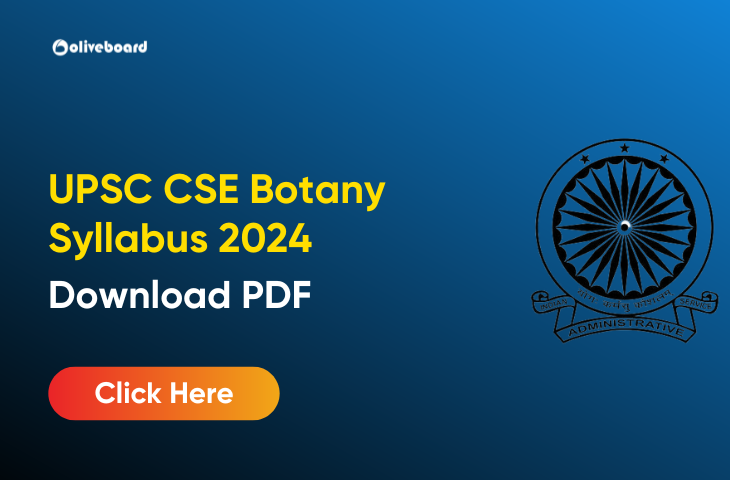UPSC Botany Syllabus 2024
The UPSC CSE Botany syllabus 2024 covers plant diversity, physiology, genetics, biochemistry, ecology, and related domains. Aspirants have to study plant taxonomy, cell biology, plant breeding, morphology, and other topics for this paper. The botany syllabus evaluates conceptual knowledge and applied skills relevant for civil services roles involving agriculture, environment conservation, and rural development.
You can download the UPSC CSE Botany Syllabus from the direct link given below.
UPSC Botany Syllabus 2024 Overview
There is a list of optional subjects for mains in which there are 48 subjects, from which candidates can choose according to their choice. Botany is one of the optional subjects for the Civil Services Exam conducted by UPSC. The optional paper is conducted for 250 marks. The UPSC CSE optional subject Botany Syllabus 2024 has two papers, Paper 1 and Paper 2.
Botany Syllabus for UPSC CSE
If you opt for Botany optional in UPSC mains, prepare it thoroughly. Go through the UPSC CSE Syllabus and previous years’ Botany papers. Also study relevant Botany books for UPSC preparation. The UPSC Civil Services Botany syllabus requires specialized knowledge in plant biology. Aspirants with academic backgrounds in botany or plant sciences are well-suited for this optional subject. The syllabus evaluates conceptual understanding of botany as a rigorous scientific discipline. It also tests the applied skills of utilizing botanical knowledge to analyze ecological issues.
UPSC CSE Botany Syllabus For Paper 1
- Microbiology and Plant Pathology:
- Structure and reproduction/multiplication of viruses, viroids, bacteria, fungi, and mycoplasma.
- Applications of microbiology in agriculture, industry, medicine, and control of soil and water pollution.
- Prion and Prion hypothesis.
- Important crop diseases caused by viruses, bacteria, mycoplasma, fungi, and nematodes.
- Modes of infection and dissemination.
- Molecular basis of infection and disease resistance/defense.
- Physiology of parasitism and control measures.
- Fungal toxins.
- Modelling and disease forecasting.
- Plant quarantine.
- Cryptogams:
- Algae, fungi, lichens, bryophytes, pteridophytes – structure and reproduction from an evolutionary viewpoint.
- Distribution of Cryptogams in India and their ecological and economic importance.
- Phanerogams:
- Gymnosperms:
- Concept of Progymnosperms.
- Classification and distribution of gymnosperms.
- Salient features of Cycadales, Ginkgoales, Coniferales, and Gnetales, their structure, and reproduction.
- General account of Cycadofilicales, Bennettitales, and Cordiaitailes.
- Geological time scale; Type of fossils and their study techniques.
- Angiosperms:
- Systematics, anatomy, embryology, palynology, and phylogeny.
- Taxonomic hierarchy; International Code of Botanical Nomenclature.
- Numerical taxonomy and chemotaxonomy.
- Evidence from anatomy, embryology, and palynology.
- Origin and evolution of angiosperms.
- Comparative account of various systems of classification of angiosperms.
- Study of angiospermic families—Magnoliaceous, Ranunculaceae, Brassicaceae, Rosaceae, Fabaceae, Euphorbiaceae, Malvaceae, Dipterocarpaceae, Apiaceae, Asclepiadaceae, Verbenaceae, Solanaceae, Rubiaceae, Cucurbitaceae, Asteraceae, Poaceae, Arecaceae, Liliaceae, Musaceae, and Orchidaceae.
- Stomata and their types.
- Glandular and non-glandular trichomes.
- Unusual secondary growth.
- Anatomy of C3 and C4 plants.
- Xylem and phloem differentiation.
- Wood anatomy.
- Development of male and female gametophytes, pollination, fertilization.
- Endosperm—its development and function.
- Patterns of embryo development; Polyembryony, apomixes.
- Applications of palynology; Experimental embryology, including pollen storage and test-tube fertilization.
- Gymnosperms:
- Plant Resource Development:
- Domestication and introduction of plants.
- Origin of cultivated plants, Vavilov’s centers of origin.
- Plants as sources for food, fodder, fibers, spices, beverages, edible oils, drugs, narcotics, insecticides, timber, gums, resins, and dyes.
- Latex, cellulose, starch, and its products.
- Perfumery.
- Importance of Ethnobotany in the Indian context.
- Energy plantations.
- Botanical Gardens and Herbaria.
- Morphogenesis:
- Totipotency, polarity, symmetry, and differentiation.
- Cell, tissue, organ, and protoplast culture.
- Somatic hybrids and Cybrids.
- Micropropagation.
- Somaclonal variation and its applications.
- Pollen haploids, embryo rescue methods, and their applications.
UPSC CSE Botany Syllabus For Paper 2
- Cell Biology:
- Techniques of cell biology.
- Prokaryotic and eukaryotic cells—structural and ultrastructural details.
- Structure and function of extracellular matrix (cell wall) and membranes.
- Cell adhesion, membrane transport, and vesicular transport.
- Structure and function of cell organelles.
- Cytoskeleton and microtubules.
- Nucleus, nucleolus, nuclear pore complex.
- Chromatin and nucleosome.
- Cell signaling and cell receptors.
- Signal transduction.
- Mitosis and meiosis; molecular basis of the cell cycle.
- Numerical and structural variations in chromosomes; significance of chromatin organization.
- Polytene chromosomes.
- B-chromosomes—structure, behavior, and significance.
- Genetics, Molecular Biology, and Evolution:
- Development of genetics; gene versus allele concepts (Pseudoalleles).
- Quantitative genetics and multiple factors.
- Incomplete dominance, polygenic inheritance, multiple alleles.
- Linkage and crossing over of gene mapping; molecular maps.
- Sex chromosomes and sex-linked inheritance; sex determination.
- Molecular basis of sex differentiation.
- Mutations (biochemical and molecular basis).
- Cytoplasmic inheritance and cytoplasmic genes (including genetics of male sterility).
- Structure and synthesis of nucleic acids and proteins.
- Genetic code and regulation of gene expression.
- Gene silencing; Multigene families.
- Organic evolution-evidences, mechanism, and theories.
- Role of RNA in origin and evolution.
- Plant Breeding, Biotechnology, and Biostatistics:
- Methods of plant breeding—introduction, selection, and hybridization.
- Mutation, polyploidy, male sterility, and heterosis breeding.
- Use of apomixis in plant breeding.
- DNA sequencing.
- Genetic engineering—methods of gene transfer.
- Transgenic crops and biosafety aspects.
- Development and use of molecular markers in plant breeding.
- Tools and techniques—probe, southern blotting, DNA fingerprinting, PCR, and FISH.
- Standard deviation and coefficient of variation (CV).
- Tests of significance (Z-test, t-test, and chi-square tests).
- Probability and distributions (normal, binomial, and Poisson).
- Correlation and regression.
- Physiology and Biochemistry:
- Water relations, mineral nutrition, and ion transport; mineral deficiencies.
- Photosynthesis, photochemical reactions, photophosphorylation, and carbon fixation pathways.
- C3, C4, and CAM pathways.
- Mechanism of phloem transport.
- Respiration (anaerobic and aerobic, including fermentation).
- Electron transport chain and oxidative phosphorylation.
- Photorespiration.
- Chemiosmotic theory and ATP synthesis.
- Lipid metabolism.
- Nitrogen fixation and nitrogen metabolism.
- Enzymes, coenzymes; Energy transfer and conservation.
- Importance of secondary metabolites.
- Pigments as photoreceptors (plastidial pigments and phytochrome).
- Plant movements; Photoperiodism and flowering, vernalization, senescence.
- Growth substances—their chemical nature, role, and applications in agri-horticulture.
- Growth indices, growth movements.
- Stress physiology (heat, water, salinity, metal).
- Fruit and seed physiology; Dormancy, storage, and germination of seed.
- Fruit ripening—its molecular basis and manipulation.
- Ecology and Plant Geography:
- Concept of ecosystem; Ecological factors.
- Concepts and dynamics of community; Plant succession.
- Concepts of biosphere; Ecosystems; Conservation.
- Pollution and its control (including phytoremediation).
- Plant indicators; Environment (Protection) Act.
- Forest types of India—Ecological and economic importance of forests, afforestation, deforestation, and social forestry.
- Endangered plants, endemism, IUCN categories, Red Data Books.
- Biodiversity and its conservation; Protected Area Network.
- Convention of Biological Diversity, Farmers’ Rights; and Intellectual Property Rights.
- Concept of Sustainable Development; Biogeochemical cycles.
- Global warming and climatic change; Invasive species.
- Environmental Impact Assessment; Phytogeographical regions of India.
| Important Links | Important Links |
| UPSC CSE 2024 Apply Online | UPSC CSE 2024 Notification |
| UPSC CSE Eligibility Criteria | UPSC CSE Syllabus |
| UPSC CSE Exam Pattern | UPSC CSE Selection Process |
UPSC CSE Botany Syllabus 2024 FAQs
The UPSC CSE Botany syllabus 2024 covers plant diversity, physiology, genetics, biochemistry, ecology, and related domains. Aspirants have to study plant taxonomy, cell biology, plant breeding, morphology, and other topics for this paper. The botany syllabus evaluates conceptual knowledge and applied skills relevant for civil services roles involving agriculture, environment conservation, and rural development.
Get syllabus PDF here: UPSC CSE Botany Syllabus
There is 250 marks is for one optional paper.

Hello, I’m Aditi the creative mind behind the words at Oliveboard. As a content writer specializing in state-level exams, my mission is to simplify complex exam information and help aspirants navigate their journey with clarity and confidence.
Having walked the path of an aspirant myself, I bring a unique, relatable perspective to my work. I focus on crafting accessible and accurate content on Exam Notifications, Admit Cards, and Results, ensuring candidates have the right information at the right time.
At Oliveboard, I play a key role in empowering students by breaking down the exam process into understandable and actionable insights. My aim is to make preparation less daunting and more rewarding, one well-informed step at a time.
